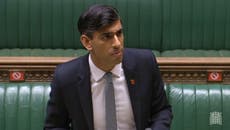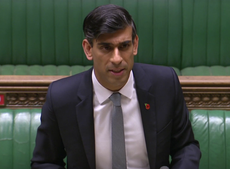When it comes to furlough it was Rishi Sunak, not his critics, who wasn’t living in the real world
The history of the past four months shows that the Treasury was not only hoping for the best, but planning for the best too, says Ben Chu


Rishi Sunak calls it a “rapid adjustment”. Others have labelled it a “five-stage U-turn”.
But what’s a fair assessment of the twisting, tortuous, history of the chancellor’s furlough scheme since it was announced in March?
First let’s give credit where it’s due. The furlough started off in a good place and it’s ended up in a reasonably decent place.
It was right for the chancellor to set what is effectively a UK version of continental wage-replacement welfare schemes during the original lockdown.
This was a risk given the job required creating an entirely new infrastructure for making payments to firms. It might well have fallen over.
It didn’t though, thanks to the competence of Treasury officials. And the scheme successfully, as the chancellor has since boasted, protected millions of jobs and incomes through the economic cataclysm of March and April and stopped unemployment going through the roof.
And the announcement on Thursday that the full furlough will be extended to March 2021 is also one of the least bad policy options available to the government as we enter into another lockdown and face a gravely uncertain winter with respect to the pandemic and the economy.
The problem lies with what happened in between the spring and the autumn.
During the summer the chancellor, as he admitted in the Commons on Thursday, was operating on the assumption that it was safe to open up the economy and wind down all the various national support schemes by October.
The first decision was forgivable, as it did look as if the virus was in abeyance. At one stage scientists were worrying that it was disappearing so fast in the population that they would be unable to test whether their trial vaccines worked.
The issue was with the timetable for winding down support. In July, when the chancellor confirmed the furlough scheme would be phased out entirely by the end of October, he suggested that it was “irresponsible” to call for “endless extensions”.
No one was, surprisingly enough, calling for “endless” furlough, but several respected researchers, not least those at the National Institute for Economic and Social Research (Niesr), were warning that the chancellor’s timetable for ending furlough looked reckless.
Others, such as the Resolution Foundation think tank, were urging the creation of a successor scheme of support for the most hobbled sectors such as hospitality, leisure and retail.
And, at the same time, France and Germany were announcing that their own job support schemes would continue well into 2021 even though their virus cases were also falling fast.
Sunak made the UK an outlier in Europe when it came to the removal of support.
The story after that was essentially one of stubbornness, followed by gradual retreat, followed by full reversal with this latest announcement that furlough will, after all, be sustained through the winter.
“We all hope for the best, but make sure we plan for any eventuality,” Sunak told the Commons on Thursday.
But the problem was that the Treasury, under Sunak, was not only hoping for the best, but planning for the best too. And it was doing so long after it became clear that things were, in fact, turning out for the worst.
The chancellor says he has been forced to make “rapid adjustments” yet the charge against him is that he was not rapid enough in changing course and recognising that people would not accept a deep cut in their incomes if the government was, in effect, preventing them from working.
Extensions and alterations have been announced at the very last minute and only when forced by decisions taken elsewhere in government.
This slowness, as many have pointed out, is likely to have had real economic costs.
Some companies, taking the chancellor at his word that support would not be extended, will almost certainly have made staff redundant who they might otherwise have retained.
There’s likely to have been a policymaking opportunity cost too. There are several deficiencies in the separate scheme of income support for the self-employed during lockdowns. Might these have been successfully addressed if the Treasury had not been messing about and resisting the inevitable over furlough?
Might the Treasury have been able to fashion a more efficient and targeted main furlough scheme if they had been given the time and direction from the top? Quite plausibly, yes.
Sunak told MPs that those who would criticise him for changing course are “not living in the real world”. But, sadly for him, the historical record of the last four months will show, with painful clarity, that it was the chancellor who had his head in the sand.
And he might have burnt up rather a lot of political credibility, quite unnecessarily, in the process.


Join our commenting forum
Join thought-provoking conversations, follow other Independent readers and see their replies
11Comments